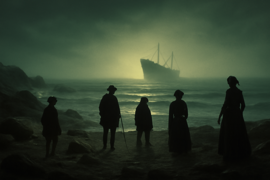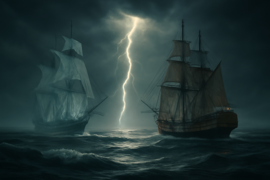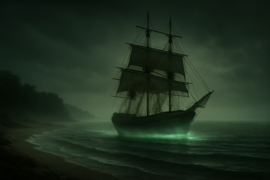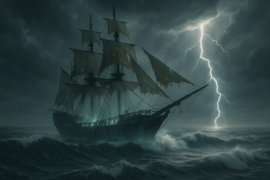Introduction
In the long shadows of the Cape Peninsula, where roaring currents collide and slate-gray waves crash against granite cliffs like a chorus of warning cries, local mariners speak in hushed tones of a vessel that should not exist. Under storm-heavy skies, when lightning fractures the night, the ghostly hull emerges—the shape of an unholy apparition gliding on the crest of each monstrous swell. Rumors trace the Cursed Ship of the Cape back to an age when prideful captains challenged the very power of heaven itself, trading vows of gold for victories over nature’s might. They say this phantom appears as a flicker at first, a broken silhouette of torn sails and rotting planks, but soon reveals every detail of its accursed deck: barnacled timbers slick with brine, rigging that snaps and crackles under phantom winds, and an unearthly green glow tracing the ship’s outline in the darkest nights. People who claim to have witnessed the sight describe a profound chill that seeps into bone and spirit, as though the ship carries not only water but the weight of unrepentant souls condemning all who dare glance its way.
Over generations, fishermen and sailors have passed down tales of how the legend took root. Some say the ship was once a proud clipper whose captain, driven by greed and blasphemy, invaded forbidden waters and mocked the storms that guarded them. In his arrogance, he declared dominion over sea and sky, vowing to sail even God’s wrath into submission. But as the first gale struck his ship, his boast curdled into terror. He watched helplessly as his crew succumbed to madness, and his vessel transformed into a draconian specter. Now, cursed by divine judgment, it roams the storm-wracked ocean off the Cape, a living warning that mortal hubris invites cosmic justice.
Tonight, when the wind whips the heather on the cliffs and the sea boils like a cauldron of dread, legend insists that those who linger too long by the shoreline may glimpse the cursed prow emerging from the fog. The elderly share their memories around crackling fires, mapping the phantom’s path with trembling fingers traced upon sand and driftwood. And though modern navigation charts and weather systems offer science a foothold against superstition, there remains a collective shiver in every sailor’s heart at the first rumble of distant thunder. For no instrument can measure the dread borne by a ship that owes its existence not to living hands but to eternal condemnation.
Section 1: The Legend Awakens
The first whispers of the Cursed Ship of the Cape drifted ashore generations ago, carried by fishermen whose nets came up empty and whose boats returned battered by unseen hands. In those early years, villages clustered along the rocky coastline reported that on nights without moon or star, a pale glow would appear on the horizon. At first, many dismissed these lights as bioluminescent plankton or distant lighthouses, but no lighthouse ever stood where the glow seemed to hover. As curiosity turned to dread, eyewitnesses began to provide details too vivid to ignore: billowing sails that billowed without breeze, the clanking of chains that belonged to no vessel in any harbor, and a low, mournful horn that rattled windows and chilled hearts.

Local clans chronicled the story in oral poetry, each retelling adding layers of foreboding. Children were hushed into silence lest they summon the phantom by speaking its name aloud. Old diviners crafted amulets from bone and driftwood, claiming they could shield a passing ship from the ghost’s wrath. One particularly detailed account spoke of the phantom’s captain—a former sea rover named Hendrik van Dyk—who dared to swear eternal allegiance not to king or country but to the storm itself. He supposedly invoked thunder and wave in his oath, vowing to command hurricanes as tools of commerce rather than hazards to be feared. But such blasphemy defied the balance of nature, and cosmic retribution came down in bolts of lightning that reduced his vessel to a charred skeleton before resurrecting it in perpetual torment.
Fishermen tell how they spotted the cursed prow breach the horizon, its rotting hull slick with seaweed, and how the sea itself seemed to heave in terror. A sudden calm would settle over the ocean as the phantom neared, as though every drop of water had frozen in dread. At that moment, experienced mariners said they glimpsed grotesque figures shrouded in wet cloth, staring from below deck as if bound by invisible chains. Then a thunderous voice, neither human nor animal, would echo across the waves: an eldritch summons for any living crew to join the doomed passengers in everlasting voyage. Many swore they felt fingers of cold reaching for them through the railing, as though the cursed ship sought fresh souls to swell its crew of lost spirits. Those who survived returned with eyes hollowed by terror, and their stories ensured that every captain checked his anchor, every lookout scanned the black expanse, and every heart pounded with the grim question: would tonight be the night the phantom claimed another?
Section 2: Encounters at Sea
On moonless nights when the wind howled like a chorus of vengeful spirits, merchant vessels dared to chart the old passages around the cape only with the steeliest resolve. Captain Marais, a Griqua seafarer famed for his unflappable temperament, set sail one October evening with a cargo of ivory and spices bound for Lisbon. His crew, seasoned docksmen who scoffed at superstition, mocked tales of the phantom as rumor and rubbish. Yet somewhere near Cape Point, the sea stilled so abruptly that Marais nearly lost control of the helm. A hush fell over the ship, broken only by the distant roll of thunder and the creak of timbers in a wind that had vanished moments before.

Then, out of the void, appeared a vessel with sails that billowed witches’ black under a sky devoid of stars. No one saw it slip through fog or emerge from behind a wave—it merely stood there, an insolent challenge to all law of nature. Aboard Marais’s ship, the lookout lost his voice, and his eyes widened in a mute scream. From the deck of the phantom, a single horn sounded, low and dreadful, unraveling the resolve of every soul who heard it. Those close enough swore the tone carried the weight of a thousand broken oaths. In that instant, Marais saw the ghostly forms of tormented sailors, their faces twisted in anguish, beckoning yet warning at once.
The merchant crew dropped everything to flee, but the phantom moved as though it cared nothing for wind or tide. It shadowed their course, matching every turn, riding every swell without the slightest pitch. Lightning flickered, revealing rotted planks crawling with barnacles and spectral figures drifting across the deck like phantoms of regret. The sea boiled around both ships, and Marais felt the weight of unseen hands on his shoulder. His first mate sobbed for mercy, confessing sins real and imagined, as though belief alone might banish the curse. When dawn finally broke, Marais found his vessel intact but rattled, with no sign of the phantom save for a single length of seaweed entwined around the prow, dripping a viscous green light. No record of the event appeared in official logs, but in every tavern along the trade route, the tale of Captain Marais joined the long line of encounters that kept the legend alive.
Section 3: Eternal Punishment
Legends diverge on the precise nature of the curse that binds the phantom to those treacherous waters. Some elders insist that Hendrik van Dyk forfeited not only his life but the souls of his entire crew by defying divine authority, condemning them to wander as shades of their former selves. Others argue that the vessel itself became a living purgatory, feeding on the fear and guilt of those who dared curse its presence. In every version, however, the moral remains the same: mortal arrogance invites a reckoning that spares neither captain nor common sailor.

In the broader sweep of maritime lore, the Cursed Ship of the Cape stands alongside the Flying Dutchman, but with a distinctly South African twist. While the Dutchman’s story often ties to imperial ambition and colonial ventures, the Cape phantom embodies a local homage to respect for nature and ancestral power. Xhosa seers once interpreted the legend through rituals of equilibrium, offering prayers at sunrise to calm the winds and ensure safe passage. Khoi-San storytellers wove the phantom into creation myths about the sea’s origin and the balance of life and death. Even today, tour guides at Cape Point museum installations feature spirit-led tours that recount how sailors used charms of sea sponge and kelp to placate the ghost, acknowledging that some forces cannot be outsailed.
Modern mariners equipped with radar and satellite communications still whisper of inexplicable signal disruptions over the Struisbaai stretch. In 1998, a South African Naval frigate recorded unusual electromagnetic anomalies near midday, though fair weather prevailed. The crew reported feeling an unseen presence aboard, and digital logs captured faint, rhythmic knocks echoing through empty compartments. No explanation satisfied both science and superstition, and within days the tale joined countless other brushes with the uncanny. Tourists visiting the Cape today purchase postcards bearing a watercolor of the phantom vessel—sails aflame with ghostlight—proof that the story endures in popular imagination. For some, it remains a thrilling ghost story; for others, a cautionary parable about the fragile boundary between human aspiration and cosmic order. The Cursed Ship of the Cape has become more than a legend: it is a living testament to the capricious power of the sea, and a reminder that some debts to nature cannot be repaid by gold or guile.
Conclusion
As centuries drift by, the Cursed Ship of the Cape remains woven into the fabric of South African coastal lore, a shadow that refuses to fade with the dawn. Visitors to the Cape stand at the lookout, scanning the horizon between errant seabirds and jagged rock spires, hoping for a glimpse of the ghostly hull holding its vigil against impossible odds. Mariners still carry protective talismans, not as a denial of reason but as an acknowledgment that some mysteries lie beyond charts and compasses. In every retelling—whether by a fireside storyteller, a shipmate on a midnight watch, or an eager passenger snapping photographs from the promenade—the legend lives on. It endures because it taps into something primal: our need to believe that the ocean, vast and unknowable, carries forces that demand respect and humility. The phantom’s slow, relentless passage across the waves whispers that justice can take strange forms, that vows made in arrogance can summon wrath older than time itself. And so the tale of the Cursed Ship of the Cape sails on, a testament to human wonder and dread, guiding each new generation to tread lightly on wind and water, lest they call forth a power they cannot outrun or outride forever.Thank you for joining these shores of shadow and storm—may your own voyages meet fair winds and kindly tides, guided by respect for the unfathomable deep that lies beneath every sparkling surface of the sea."


















